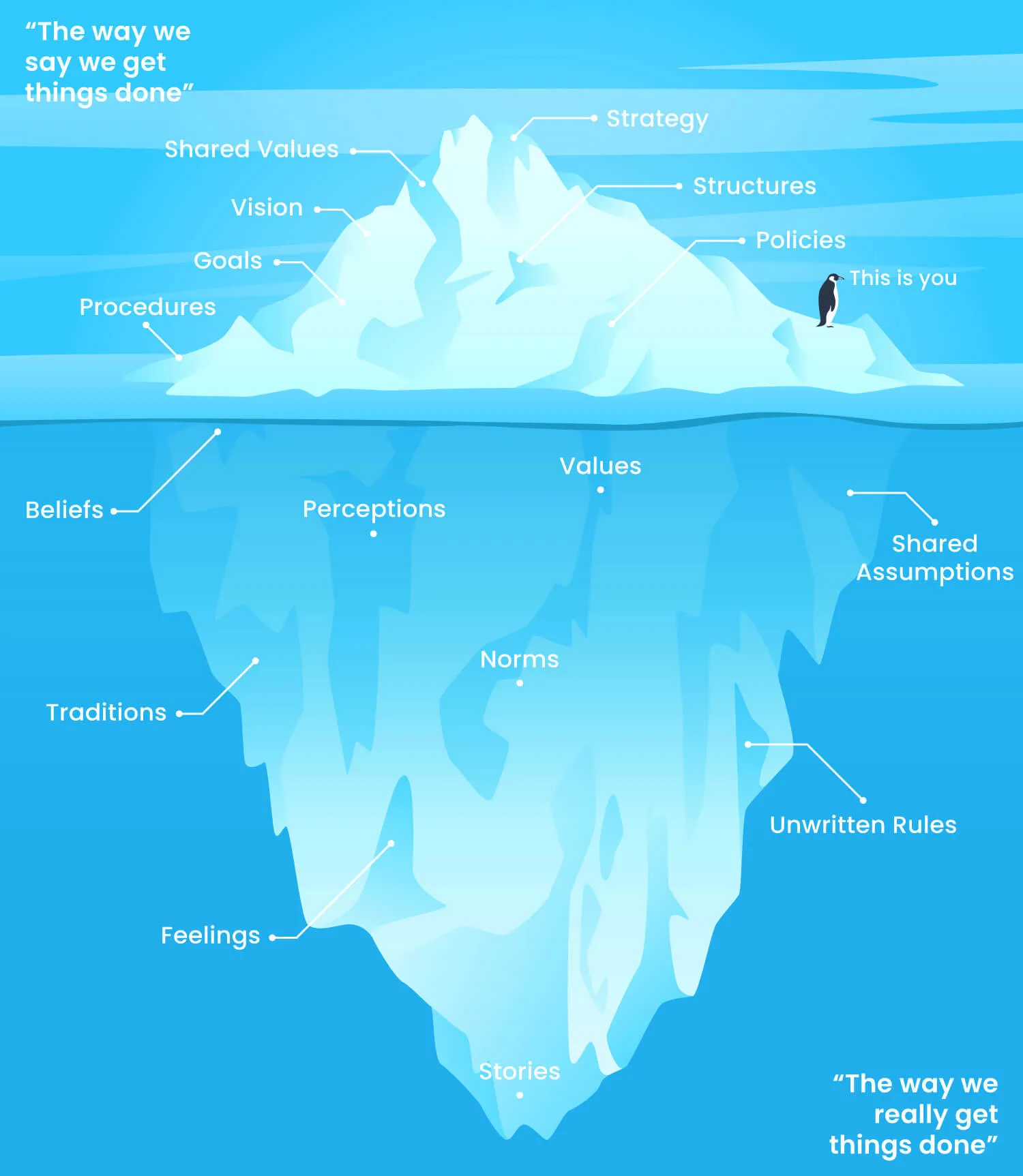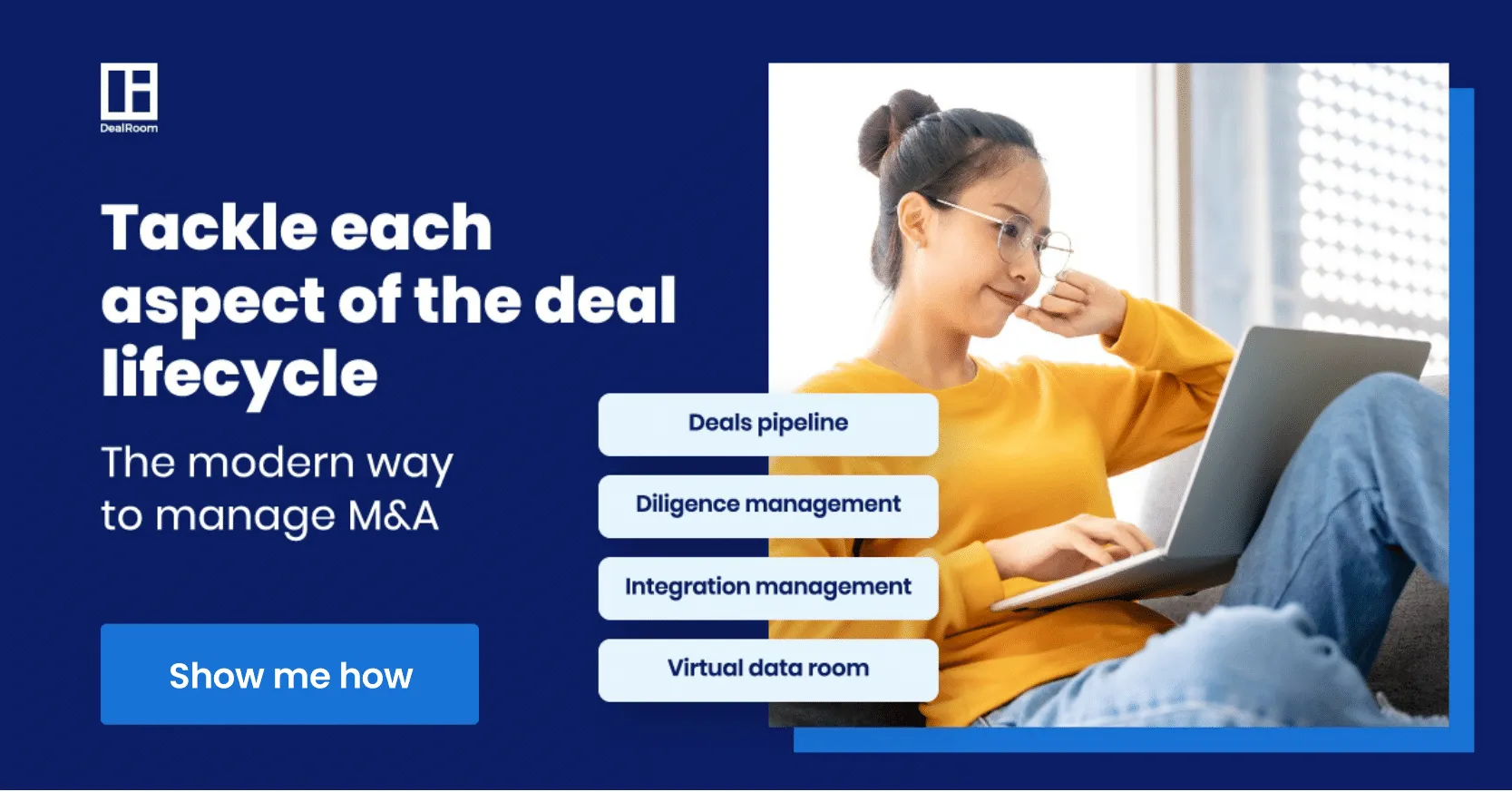History is littered with mergers and acquisitions that failed because of an inability or unwillingness to grasp the importance of addressing culture.
Academic research conducted across different timelines, industries, and geographies shows that the synergy targets set out at the beginning of a transaction are far more consistently achieved when culture is managed effectively.
Culture is therefore far less of a ‘soft issue’ than some M&A practitioners believe.
DealRoom helped dozens of companies organize their M&A process and in this article, we look at the impact of culture on M&A, and how it can be effectively managed to maximize value from every transaction.
What is corporate culture?
Before diving into the relationship between culture and M&A, let’s first understand what we mean when we use the term culture. Culture refers to an organization’s values and behaviors, underpinning how the organization performs its day-to-day actions, as well as its strategy and mission.
Culture in the corporate context is sometimes explained colloquially as ‘how we get things done around here.’
Determining organizational culture
The idea of culture causes a lot of problems because companies find it hard to pin down. How can they detect something which they believe to be in the ether?
This is erroneous. Culture is not in the ether.
It’s an unwritten set of standard operating procedures that a company has. It’s how the company behaves when people aren’t looking.
The good news is that all of these things can be defined by asking the right questions.
Culture can be determined through a cultural assessment - or cultural due diligence. Like any other kind of due diligence, this requires that a company audit a culture, asking the right questions of the right people is paramount.
Identifying organizational culture is the first step of successful cultural due diligence. If this sounds difficult, think of all the people that your company hires on an ongoing basis. Think of good people that weren’t a good fit. Cultural due diligence is basically doing this en masse.
The earlier this starts, the better. Issues to assess include the following (be mindful of the fact that all of the assessments need to be made relative to an honest self-assessment of the buyer’s firm):
- Defining ‘success’: Perhaps the most important question of all - what motivates employees (incentives, promotions, achieving and surpassing KPIs, lifestyle, etc.).
- Management approach: How big is the distance between management and staff at the target company? Is there constant interaction between them?
- Decision-making approach: How much autonomy does the staff have to make decisions, and how important are those decisions?
- Willingness to change: How open does the team appear to change? Have things always been done the way they’re done now or has there been constant evolution?
- Current workforce attitudes: How content are the workforce currently and what are their concerns about the takeover? (conduct a confidential survey if you deem it suitable).

What part does culture play in M&A?
Unsurprisingly, ‘how we get things done around here’ can have a major bearing on how transactions fare.
The consolidation of the income statements of two companies is a relatively straightforward exercise that investment bankers like to undertake to show the post-merger earning power of the two companies.
But exactly how were the incomes earned?
There’s a strong chance that even companies that seem closely related generate income slightly differently - that’s culture.
Examples abound. When Amazon acquired Whole Foods in 2017, to many on the outside, it looked like a match made in heaven.
Amazon would gain a foothold in the groceries industry, and Whole Foods would become the most technologically capable of all of its competitors.
But the cultures were miles apart. Amazon is about speed and efficiency. Whole Foods is about ethics and personal service. If cultural differences had been acknowledged, the deal may have even happened.
Of course, understanding this culture demands that companies undertaking mergers and acquisitions are completely honest with themselves about their own culture.
They need to ask hard questions about how their suppliers, employees, customers, and other external stakeholders.
- Are they as innovative as they like to think they are? (and if so, what have they innovated in the past five years?).
- How ethical are they, really? (Greenwashing is still remarkably common).
Thus, it's important to understand the culture on both sides of the transaction.
Merging two different organizational cultures
As with any other stage of due diligence, cultural due diligence is best conducted using a project management tool like DealRoom.
This should be seen as the very first step in the process.
Cultural due diligence is rarely the most challenging part of the due diligence puzzle, but it is usually the most unwieldy, demanding that the buyer creates an organized process, and makes answers about employee motivations and emotions as measurable as possible.
A good process is:
- Identify cultural differences (see section above).
- Establish what can be changed without destroying value. For example, if personal relationships are what drive most of the value, don’t simply believe that the client relationship can be transferred to an automated CRM system.
- Understand the target’s ‘hygiene factors’ and ‘motivators’ - what do they need at a minimum to be happy in their positions, and what would make them work even harder? This could be something simple like dressing down in the office or working from home twice a week, but it’s important to have a good understanding of it.
- Be fast: Nobody likes the idea of being a company in constant flux. The longer it takes to ask everybody questions, the more likely you’re going to run into trouble. Ensure that everybody is contacted about their opinion, and let them know (or preferably show them) that their voice matters as soon as they’ve been heard.
- Create a roadmap for cultural success. This means collating the findings from sections 1 and 2 and comparing them to your own company and how the target fits culturally. Which aspects are going to require the most attention? Employee incentives? Bonus packages? Control systems? Take a systematic approach and go through every detail one by one, ensuring not to take any shortcuts (a sure way to destroy value in the deal).
Read also:
How to Assimilate Unique Cultures in Mergers and Acquisitions (insights from Microsoft)
Tone At the Top: Intersection of Leadership & Culture in M&A
Staying True to Culture in M&A
How does national culture affect global company mergers?
Talking about national cultures these days is a minefield but let’s be honest - every country has its positives and negatives.
It’s important when acquiring a company in another country that cultural due diligence is approached with that mindset:
Your culture isn’t better than the other side, it’s just different.
When acquiring a foreign company, take all of the same steps - just more tentatively. It’s still just a company - it’s probably just even more different to your company than one in your own country.
What is a culture clash?
You generally won’t need to wait for long to see if there are culture clashes: they’ll come and find you. The best way to define a culture clash in the context of M&A is that it happens when companies change the way they operate and it has some detrimental effect.
The detrimental effect could be employee morale (something that needs to be tracked closely after a transaction), revenue and costs, or some other operational facet of the business. The danger is that you think these are small and insignificant.
Think of them instead as a small carbon monoxide leak for the long-term success of the deal.

Examples of culture clashes
One of the most famous examples of a culture clash was the ‘merger of equals’ between Daimler (the parent company of Mercedes Benz) and Chrysler back in the 1990s.
Within a couple of years, it was being called ‘a fiasco’, dogged by significant culture clashes in areas such as formality, philosophy, and salaries.
Surveys showed Chrysler employees’ satisfaction levels bottoming out, so something had to be done. Daimler sold Chrysler to a private equity company in 2007, ending the auto industry’s most unhappy marriage.
The Technology, Media, and Telecoms (TMT) industry are also fraught with difficulties in culture, with firms often knowingly or unknowingly developing a unique internal culture that can be hard to repeat.
In 2005, Sprint acquired Nextel for a cool $35 billion, and within three years had written down 80% of that value.
The reason?
A culture clash between Nextel’s startup-style culture, and the more corporate and bureaucratic Sprint.
Reportedly, the culture clash affected everything from overall strategy to company advertising.
Planning for a cultural integration after a merger
By now, you should be convinced of the impact that culture can have on your transaction. Prepare accordingly. From the beginning of due diligence onward, take culture into consideration everywhere.
Here are a few final thoughts:
- Get the frank and honest thoughts of the management team from the target company about what culture means to them, and how they would go about making a change if it were required.
- Make culture measurable. Wherever possible, generate data from the process. This means scoring cards that allow you to track progress, numbers attached to salary expectations, KPIs for targets set for employees, and more.
- Ensure the right people are in charge of culture. If you’ve got someone who isn’t a good representative of your company’s own culture (i.e. they’re not even a fit for the company they work for), the whole exercise may end up being pointless.
- Learn from the experience. This isn’t a throwaway statement. There are likely to be several aspects to the target company’s culture whose adoption by your company could improve your overall culture. Keep an eye out for these and be open to change.
Conclusion
Culture matters at every level of an organization.
Just because you hit it off well with the CEO of the target company, it doesn’t mean that there are no massive cultural issues just under the surface that could undermine your transaction. Confront them now so that you don’t have to later.
Make cultural due diligence an integral component of your deal process and maximize the chances of your acquisition generating long-term value. DealRoom team can help you with that, just leave us a message.




















.png)
.webp)



.webp)
.webp)
.webp)





.png)
.png)
.png)
.svg)

.svg)
.png)
